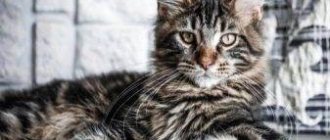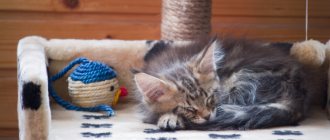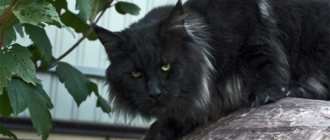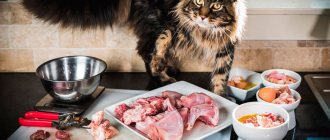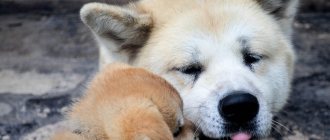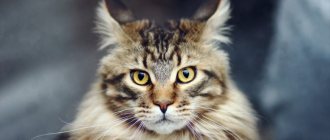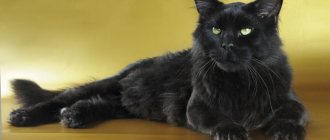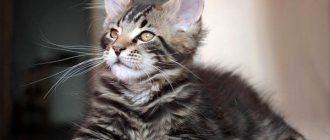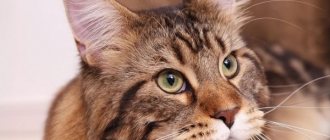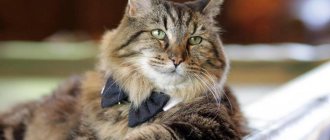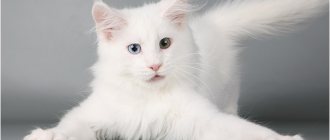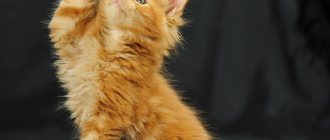From a genetic point of view, Maine Coons have two main coat colors – red and black. All other shades are different variations of the basic ones. All the variety of colors and patterns appears due to the special distribution of hair pigment, which determines the color of the animal.
Determining the hereditary color allows you to find out which cat's offspring will appear. Maine Coons are no exception here. To do this, breeders use special tables with formulas that will tell the color of future kittens. Based on them, you can decide how to cross the adults to get the desired result.
Maine Coons of different shades.
Traditional Maine Coon colors: photos and descriptions
There are several types of coat patterns called tabby.
They all have their own patterns. Tabby was inherited from the wild ancestors of modern domestic Maine Coons. Their distinctive feature is the letter “M”, which is visible in the area of the cat’s forehead and eyes with light or dark lines. There are three types of tabby:
- Tigers. The stripes on the body are parallel to each other.
- Spotted. There are spots of dark and light shades on the sides.
- Classic. Similar to the pattern of marble.
There is also a fourth type - ticked, but it is not typical for this breed. It is usually found in the Abyssinian breed and other oriental cats. It may appear in isolated coon individuals.
Often there are uniform colors in the same range; they are called solid or in the English version - solid (uniform). In this case, the tabby can be almost invisible. Often found in cats that are black in color. The darker the cat, the weaker the pattern of its coat appears. Tabby is especially pronounced in cats with fur of red (red) shades. Solids can be in the following palette:
- black;
- cream;
- red;
- smoky;
- blue.
Smoky gray and blue are of particular interest to Maine Coon breeders, as they are very rare for representatives of this breed. The gallery below shows photos of popular colors.
Maine Coon color calculator
To understand what color will result from crossing animals, breeders use a calculator table. With its help, you can predict with a very high probability what color the offspring of a thoroughbred couple will inherit.
How the coat colors of Maine Coon offspring interbreed.
This is, of course, not a guaranteed result, as it is impossible to calculate the exact genetic combination a kitten will inherit. From time to time, extremely interesting representatives of coons are born, having, for example, tortoiseshell tones, which is very rare for this breed. It has been noticed that most of these individuals are female.
Gray Maine Coon
Gray or blue colors are considered rare for this breed.
An even color of blue shades is a rare occurrence. A smoky shade is usually found. These cats look special; their color gives them their aristocratic charm. If a cat is exactly like this, it means that the gene responsible for the presence of a pattern on the body has been completely suppressed.
Blue tones are specially developed through selective breeding. This takes a lot of time and effort from breeders. The letter “A” is placed in the passport of such a kuna. If the cat has two-color fur, the code “03” is added to the letter designation.
Character traits
The Maine Coon, whose photos always turn out beautiful and attractive, has a calm disposition by nature. This animal is not aggressive and therefore gets along well with all other animals.
Due to their meekness, representatives of the breed may seem arrogant, but this is far from the case. In fact, they become very attached to their owner and feel sad when he is not at home.
With great pleasure, the Maine Coon, whose size is quite impressive, goes for a walk, allowing him to put on a leash. In general, the disposition of the representatives of the breed is cheerful and good-natured.
When an animal is in the mood, it is not averse to playing and having fun. We can say that until its very maturity, part of the animal remains a Maine Coon kitten.
The weight of the animal and its large size do not interfere with having fun and actively moving. And here it is worth saying once again that, despite their large parameters, the individuals are not fat; on the contrary, their body is very strong, hardy and muscular.
Particular attention should be paid to intelligence. The thing is that by nature this animal is very smart and intelligent.
It has an excellent memory and remembers voices and intonations well, and can recognize its owner from a thousand. If desired, this animal can always be taught various tricks and performing simple tricks.
Working with an animal is a pleasure. Moreover, cats love to walk in nature. You can safely take them with you out of town, on short trips. They also handle the road quite well.
Another unusual side of the cat is its melodic voice, which is also difficult to confuse with any other. Moreover, it is interesting that each individual has its own voice timbre, unlike the others.
Non-aggressive by nature, the animal easily gets along with children, appearing before them as a kind of friend.
But what these cats will not tolerate in their environment is rodents. It is quite possible that such rejection is associated with the brutal instincts still living in the Maine Coon, pushing him to hunt.
On the other hand, a representative of the breed will be simply indispensable for a house in which mice live. With its appearance, such a problem can be forgotten once and for all. The Maine Coon is very attentive to strangers, but he is in no hurry to let people get too close to him, waiting to see how the owner himself will treat the guest.
So, summing up the positive traits that are inherent in the Maine Coon, we can say that these cats by their nature:
- Non-aggressive;
- Obedient;
- Peace-loving;
- Friendly;
- Flexible;
- Calm;
- They respect their masters;
- Get along well with children;
- Not conflicting;
- Unpretentious in care;
- Attractive;
- Smart enough;
- Active;
- Cheerful.
And those who have already read the reviews of Maine Coon owners want to have a pet of this breed. Considering the number of pros and not a single minus, it is very easy to understand them.
The rarest and most expensive Maine Coon colors
Each breed has rare colors that are not often seen. Maine Coons are no exception. This breed has its own rare shades:
- Brown with spots. These kittens have a color similar to autumn foliage.
- Creamy blue. Looks like tortoiseshell with rare pastel shades.
- Chintz. This is a unique coloring for coons. The base is red, diluted with black tones with white splashes.
- Watered down chintz. There are cream-colored spots on a white background, and blue colors have a solid coloring.
- Spotted with white spots.
Such colors are not typical for coons and are rare.
Smoky
Such cats can be black or blue. The intensity of the haze determines the subspecies:
| Name | Description |
| Chinchilla | Only the tip of the hair is pigmented |
| Shaded | color has a quarter of the hair |
| Smoke | Only the root of the hair is colored white, the main part has black or blue pigments |
| True smoke | Half of the hair has pigmentation |
| Silver | the hair is white at the root, the rest is light silver |
| Cream | at birth, the coat is uniform in color, but gradually becomes unevenly pigmented |
| Classic wild | brindle, marbled black, spotted |
Smoky cats are characterized by white roots. Gray is usually found in monochromatic animals.
Chocolate
The wool is colored brown, warm, rich. The presence of inclusions of other shades or patterns is not allowed. The hairs have an even distribution of pigment. Unlike red tones, it is darker and deeper. Quite rare in breeding. The paw pads and nose also have brown tones.
Classic wild
This color suggests the presence of a pattern on the animal's fur. They can be of different types:
- brindle;
- marble black;
- spotted.
These are the main colors of coons that were common among their wild ancestors.
Peach
These cats have similar features to their cream counterparts. These can be yellow, orange shades characteristic of tabby coons.
Black
Black monochromatic coloring is extremely rare for this breed.
Each black coon has a different color depth and saturation, so it is impossible to find two identical black cats. Usually, this color hides the pattern on the coat. In small kittens it can be difficult to see, but as they grow older it is completely hidden. The cat becomes completely monochrome. An animal with black fur looks regal, luxurious, reminiscent of a majestic panther in appearance.
Black and white
Cats with this coloration have different proportions of these colors:
- Black with white spots. There are several small spots of white on the fur.
- White medallion. A white spot is located on the chest of the animal, reminiscent of decoration.
- White gloves. The cat has black and only white paws of the animal.
- White tuxedo. There is a white shirtfront on the neck, and the paws are also white.
- Bicolor. Black and white in a 1/1 ratio.
- Harlequin. The color is predominantly white with a few black spots.
- Wang. The head and tail are painted black. The rest of the body is white.
What is the danger of white color
White Coons have a predisposition to complete deafness.
It is found in this color much more often than in animals with a different shade of fur. However, there is no need to be upset by this fact. Deaf individuals feel great.
They live well in the house, and are oriented to the area no worse than healthy ones. Their hearing loss is compensated by vision and a keen sense of smell. People who do not know about cat deafness will not guess about it.
Cream
This shade is obtained by lightening the red. The animals are colored in shades similar to raw ginger. When crossing, individuals with genetically weakly expressed pigment in the pedigree are preferred. However, theoretically, even Black Solid Maine Coons can produce cream-colored offspring.
Contents: how to care for a cat?
After the owners have brought the pet home, it is not recommended to carry out bathing procedures for several weeks in order to protect the animal from stress. You can only comb the coat using a hard specialized brush once a week. It is necessary to purchase a scratching post for your pet, making sure to pay attention to the strength and height of the product. After adaptation, it is important to bathe the animal. The adoption of water procedures should be carried out with shampoos and conditioners, after which the pet must be wiped dry with a warm terry towel. If there are fleas in your cat's fur, or to prevent their appearance, you should use specialized medications. Experts do not recommend bathing Maine Coons with black smoke before and after vaccination and if the cat has had any illness. It is necessary to clean the eyes and ears as they become dirty with cotton pads or a soft cloth moistened with warm water.
Tortoiseshell
The tortoiseshell Maine Coon comes in two types – torby and torty.
The first type is a combination of red and black shades of wool, expressed in a dark brown color. The torti has a greater addition of red with dark cream. Of particular interest is the fact that tortoiseshell coloring is most often found in cats.
The probability of a male being born with this coloring is approximately 1 in 1000.
On such cats, markings of different sizes and shapes are more clearly visible. Based on the severity of these spots, several colors can be distinguished:
- calico;
- flap;
- chintz.
These cats are characterized by the presence of red shades of fur. The classic color, consisting of three colors, is obtained by mixing black and red. This makes the coat more variegated. There are also several tortoiseshell shades.
Scaly tortoiseshell
Reminiscent of fish scales, the order of spots on the body is checkerboard. These spots alternate in black and red tones and are unevenly distributed. Any one of the colors may predominate.
Calico and solid tortoiseshell (patchwork)
The spots of black and red color resemble flaps. They have defined boundaries and can overlap each other. If the wool has white patches, this color is called “tortoiseshell white” or calico. Red and black spots are solid in color and clearly visible on the animal’s body.
Patterned tortoiseshell
Multi-colored spots have a pronounced pattern. These may be spots or stripes, but marbled colors are also common. There may be small white spots. In this case, it is fashionable to say that the color is spotted tabby or tabby with white spots.
Solid colors
Solid Maine Coons are the result of the successful work of professional breeders. This type of color is called just one word “solid”.
The color of almost every animal of this type will, upon careful examination, have vague hints of stripes; it can appear like a shadow. But the main impression is a single color. Depending on the shade, these stripes appear brighter or paler. It's almost impossible to compare stripes in bright red and cream. The stripes appear least in white cats, although at the age of kittens the pattern on their heads is still visible, but becomes more blurred with age.
Marble colors
Can be cold or warm tones. The first has more gray tones, while the warm one is dominated by brown shades. These stains sparkle in the sun in a special way, which many people like. Such stains can be drawn in different ways - stripes, spots, contours. Such spots can be well defined, then they are more reminiscent of a tortoiseshell color. Marble coloring has more diffuse, blurred borders of spots.
Tabby
This type of coloring is present in all representatives of the Maine Coon breed, but may not be expressed in a bright form. This color is a genetic predisposition. A cat's hair has its own zoning or striping. The wild ancestors were tabbies, which was inherited by modern representatives. There are various options for this design.
Classic, spotted and brindle tabby
Characterized by wide stripes of a spiral shape. They are usually located on the sides of the animal, and can resemble marble stains. Spotted tabbies have intermittent stripes or spots of color throughout the animal's body. The brindle tabby is similar to the brindle coloring - vertical stripes along the entire length of the body.
Ticked Tabby
These cats have no stripes or spots at all. The fur has a peculiar pattern on the face, paws, and chest. Ticking is the distribution of pigment along the hair. The tip has a rich shade, gradually losing brightness towards its root.
Silver and smoky colors
These colors of Maine Coon cats look especially beautiful and impressive. The base of each cat hair is white and the tip has pigment.
There is a regular smoky shade, “shaded smoke” and “chinchilla”. Silver cats can have beautiful green eyes.
The most valuable of the smoky cats are those with the colors “marble and silver”.
Their fur has a beautiful spiral pattern, similar to marble. Peach cats have white hairs at the base and a reddish tip.
Silver color in a Maine Coon/Yandex Collections
Random color combination
Sometimes there are situations when the maine has a color that does not fit any of the color types. For this purpose, its own classification was created. These colors can be called:
- Brown tabby with spots. Such an animal has spots of red and brown.
- Blue spotted tabby. The cat in this case has cream and blue stripes on its body.
- Creamy blue. The spots are scattered in a chaotic manner throughout the body. This color is sometimes called a blue turtle.
- Creamy blue, white.
- Spotted tabby with white spots. The color is similar to the previous one, but there are inclusions of white spots.
Such combinations are also rare.
Unrecognized
Chocolate, gold, and lilac colors are not allowed at specialized exhibitions. Coons with Siamese coat color are also not recognized. There are patterns that are considered unrecognized for the Coons. These can be called:
- faun;
- cinnamon;
- point;
- sorrel;
- acromelanic color.
The coat color of Maine Coons is distinguished by a huge variety of colors and their combinations. The eyes of purebred animals must match the color of their fur. They can be blue (only pure white wool), green, yellow. White individuals may have different colored eyes (blue and green).
EMS color code
The International Association of Felinologists has developed a table that includes color options recognized by professional breeders. We need such a systematic collection for the convenience of making entries in the pedigree of the animal, bringing information about the breed to a single standard.
Unified table of coat colors according to EMS coding.
Thus, all colors not included in the standard coding are considered coat color defects. Individuals with unrecognized colors are not allowed at exhibitions and are not used in breeding.
However, they are suitable for home keeping in the same way as those with coat colors included in the table. Representatives of this breed have many genetically determined color options. Each Maine Coon is beautiful in its own way, no matter what color nature gave it.
History of origin
Over the entire period of their existence, Maine Coons have acquired an incredible number of theoretical assumptions and legends, which are often completely isolated from reality and have no basis in truth.
Although some are very curious and arouse interest. For example, you can often come across a plausible legend about the love between a cat and a raccoon, and the descendants inherited such a color and a long, fluffy tail from the “mother.”
Judging by another version, Maine Coons are the offspring of farm cats and the North American lynx, the combination of which determined the breed’s distinctive characteristics.
In fact, the origin story of the “giants” begins in Maine, which is officially considered the birthplace of the pet.
Only an organism adapted to such conditions can withstand harsh climatic conditions, which is what affected Maine Coons.
Large animals, whose endurance is impressive, were able not only to survive, but also to form into a specific breed with its own distinctive characteristics. True, Maine Coon cats appeared in our country relatively recently - in 1992.
